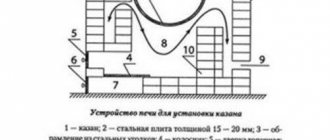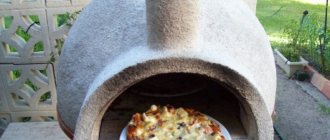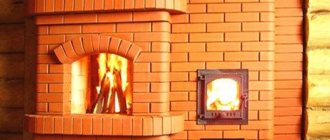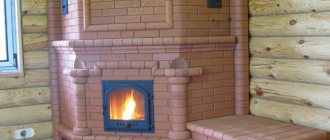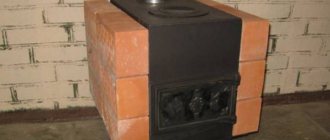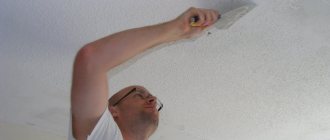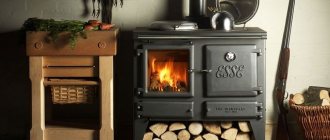Wood-burning stove with high efficiency Both heating and heating-cooking stoves have recently become a permanent attribute of a large private house or cottage. Many people are satisfied with such designs without even caring about their feasibility or performance.
Meanwhile, the efficiency of the stove in a modern house is often indecently low, which causes excessive fuel consumption, the additional need for emergency fires and banal extra expenses. How to increase efficiency, what tricks to resort to?
Modern stoves are not at all the potbelly stoves that we remember well and dislike for their ubiquity and extremely low, up to 5% , efficiency. And in design, and in purpose, and in appearance. With the right approach, you can achieve furnace efficiency of up to 85% and even more! How to increase the efficiency of a wood-burning stove, what should you do and what should you choose when purchasing if you don’t want to lay the stove yourself? Follow our advice and recommendations, be guided by the choice and preferences of specialists.
How to increase efficiency
When designing or modifying a wood heating system at home, you should remember the basic rule - all elements must be proportionate, optimal and form a harmonious system. A huge firebox with little heat removal will reduce the level of efficiency, and vice versa, excessive heat removal will lead to operational problems.
The concept of “efficiency” means how much energy released during combustion is transferred in the form of heat to the heated room. This characteristic is influenced by a number of factors:
- Serviceability and cleanliness of the stove.
- Type of fuel burned.
- Fuel burning mode.
- Heat transfer method.
- Heat supply efficiency.
- Availability of additional fuel attachments.
Stove serviceability
A significant decrease in the efficiency of the furnace occurs when it is used incorrectly. There are different ways to burn wood, and if you burn it incorrectly, heat energy will be lost.
The soot deposited on the walls of the heat exchanger is an excellent heat insulator. To increase the efficiency of the furnace, you need to periodically, once every 2 months, clean all important parts from soot.
Attention! Soot in the furnace ducts and chimney can catch fire; do not allow deposits to accumulate in the heating system. Soot combustion is a common cause of fires!
The right fuel for your furnace
It is known that different types of wood produce different amounts of heat. You can increase the efficiency of your stove by using the right fuel. Hard types of wood - oak, acacia, ash - have a greater calorific value. In addition to density, an important characteristic is the moisture content of the firewood. Firewood with a moisture content of 15% is considered optimal, but such indicators can be achieved either by using a drying chamber, or by natural drying under a canopy for 2-3 years in ventilated stacks.
Optimal combustion modes
The fuel combustion mode is also important. There are different ways to burn fuel efficiently:
- In the mode of pyrolysis decomposition and afterburning of gases.
- In optimal fast combustion mode with sufficient oxygen access.
- Layered combustion of fuel from top to bottom.
Pyrolysis mode
When burning fuel in pyrolysis mode, the efficiency of the furnace increases due to the long combustion time. The firebox is divided into two chambers - a smoldering combustion chamber, where in a slow mode the firewood decomposes into pyrolysis combustible gases, and a gas afterburning chamber. Technically it looks like this:
- Firewood is placed in the firebox; initially, combustion occurs in a hot mode with the supply of a large amount of air. This stage is necessary to create a fire cushion on the wood, as well as to warm up the chimney and the secondary afterburning chamber.
- The firebox door closes. The air supply is set to a minimum - so that there is enough for smoldering. Firewood decomposes into smoky pyrolysis gases, which pass through a hot afterburning chamber.
- The second chamber has secondary air ducts. They are aimed at a catalyst - a massive red-hot ceramic or metal object. In some furnaces, the wall of the secondary chamber acts as a catalyst.
- Relatively cold pyrolysis gases, passing through the catalyst, are heated, mixed with air and burned.
This ensures complete combustion of the wood. The efficiency of pyrolysis combustion plants can reach 85 - 90%.
Disadvantages of this method of burning wood:
- Difficulty in realizing optimal combustion.
- Impossibility of altering existing fireboxes.
- Cold gases in the chimney turn into condensation, which floods the chimney.
Advantages of this combustion method:
- Duration of work on one tab. In Buleryan stoves, one bookmark is enough to burn for 5 - 8 hours.
- With the correct design of the firebox, the efficiency is high.
- Constancy of generated energy.
Forced combustion
The rapid combustion of firewood in a firebox with a sufficient amount of air will be optimal only if there is a large heat exchanger that can quickly store and retain a large amount of heat. In this case, it is ideal to use water as a coolant, and a large insulated tank as a heat accumulator.
To burn a large amount of fuel in an optimal manner, you will need an ash chamber and a grate. They can be organized in any existing firebox made of two metal plates or bricks. Installing an ash pan in a ready-made firebox will reduce the volume, but will add combustion efficiency.
How it works:
- A large amount of fuel is immediately placed into the combustion chamber, which will burn throughout the entire mass from the bottom up.
- After kindling, the main door closes, the ash pan door opens, and the combustion is regulated.
- The flame should be smooth, hot, without jerks of detonation or pops. The color of the flame is straw with red or blue streaks.
- In this express mode, combustion continues until coals are formed. The ash pan door is closed, the firebox operates in slow mode.
Features of application:
- An oven with a grate can be converted into a hearth by covering the grate with a sheet of metal.
- Brick channels or a massive bell-shaped structure can provide good heat removal. An incorrect ratio between a powerful firebox and a small heat exchanger will lead to a significant amount of heat being “blown out” onto the street.
- You cannot use this mode if there is poor draft - this will lead to smoke inside the room.
- Not every firebox can withstand the heat of burning dry wood. Plain red brick or thin metal can burn or crumble. If possible, use this mode in fireboxes lined with fireclay bricks.
Gradual combustion of fuel
Fast mode with layer-by-layer combustion of wood can be achieved using special air supply systems. This solution is implemented in Stropuva long-burning boilers, but simple fireboxes are quite suitable for conversion.
One or more air ducts made of pipes are inserted into the firebox. Their purpose is to supply air to the combustion site. Air ducts run from the door to the top of the firebox. Slotted holes are cut in the vertical sections of the air ducts. The firebox works like this:
- Firewood is packed tightly into the firebox and can be sprinkled with sawdust or peat. Kindling made of paper and wood chips is lit on top of the bookmark. Until it flares up, the firebox operates in the mode of a conventional deck oven.
- When the kindling flares up, smoothly close the firebox opening with a sealing metal sheet. The sheet has holes for air ducts. The sheet must fit tightly to prevent air from entering the thickness of the fuel.
- The fuel burns using air from the duct. Combustion is optimal, but produces a small amount of heat.
- The fuel burns gradually, first of all burning out near the air duct. If the fuel is burned far from the tube, the air may not reach the combustion site. It is worthwhile to arrange several air ducts evenly, connected to one intake hole.
This combustion method has only one advantage - a long period of autonomous operation. Increased efficiency is achieved thanks to the gradual combustion mode; even a small heat exchanger is able to capture heat and transfer it to the room. This method is perfect for upgrading potbelly stoves and wood-burning boilers, but it is not suitable for brick stoves. An advantage will also be the ease of retrofitting existing fireboxes - anyone can design and manufacture air ducts and a sealing plate from pipes and sheet metal.
Disadvantages of this method of burning wood:
- Difficulty loading firewood.
- Difficulty of kindling.
- It’s difficult to control the intensity of the flame - you can’t open it and “look” at it. You will have to use indirect methods - a thermometer in the heat exchanger.
- Inability to “throw” firewood.
Thermal power
Let's start considering the parameters for choosing heating equipment by assessing the thermal power. In an effort to save money, some buyers choose a small, cheap stove, which in practice cannot cope with heating tasks. Its power is not enough to provide heat to a large room. At the same time, a stove that is too large can also create a number of difficulties:
- dry air in the room;
- too high uncomfortable temperature;
- high fuel consumption;
- formation of a large amount of soot and soot.
Important! When assessing the power of the model you like, take into account the dimensions of the room and the likely heat loss - how windy the windows are, whether the attic is insulated, whether the walls freeze.
To calculate power you can use a simple formula:
- Multiply the length of the room with the width and height.
- Divide the resulting number by 14.
This way you will get an indicator in kilowatts that you can use as a guide when purchasing. Keep in mind that some manufacturers indicate its maximum power in the passport for the device, so take a model with a small margin so that its capabilities are enough to heat your home or cottage.
“TOP-model-140” with cast iron door
Characteristics:
- thermal power – 14 kW;
- maximum area of heated premises – 140 m3;
- door type – cast iron, with glass panel;
- chimney diameter – 115 mm;
- weight of the structure – 69 kg.
Price – from 16,260 ₽.
Product link: https://sadpom.ru/products/pech-otopitelnaya-top-model-140-s-chugunnoj-dverkoj/
The rating of wood stoves opens with the TOP model 140, designed for convection heating of buildings. This is a medium-power device that does an excellent job of heating large spaces with a volume of 70 to 140 m3. A rapid increase in temperature is achieved due to hot air flows that heat up inside the oven and exit through special holes in its upper part. The unit can be used in conjunction with a mounted heat sink, which will allow heating adjacent rooms.
Advantages of the model:
- efficient three-turn firebox;
- the ability to heat food on the upper platform;
- increased service life due to a flame arrester made of stainless steel;
- compact dimensions with average power ratings.
Flaws:
- dust entering the air along with air currents;
- Coal and wet wood should not be used for heating.
Back to Contents
Heat removal optimization
You can increase the efficiency of your heating system by removing a large amount of heat and transferring it into the room. You can do this in two ways:
- Infrared radiation - from a burning flame or hot walls.
- Heating air or water in the firebox.
Hearths were traditionally heated with open flames in Europe. A fashionable fireplace has a low efficiency, but it only uses infrared radiation. The light of a burning flame in conventional stoves is used to heat the walls of the firebox. In most cases, heating the firebox is not beneficial. You can use part of the heat emitted during bright combustion with a transparent door of a large firebox. You won't be able to use plain glass - it might break. Heat-resistant glass is inserted into the doors.
Heating-type stoves have proven to be effective. The Winter Palace, the Hermitage, and the Arsenal were heated by Uttermark stoves. The burning fuel heated the pipes in which the air moved. Such heating made it possible to obtain fantastic results in terms of speed and efficiency. By laying dry pipes in the firebox, you can quickly warm up the room with dry warm air. In residential premises, you can use forced air supply, influx from the street and humidification. This way you can control not only the temperature, but also the humidity, as well as the amount of carbon dioxide. The downside is the difficulty of implementation in ready-made brick kilns.
By inserting a central heating circuit into the furnace, you can increase heat output and effectively transfer heat throughout the building. In this case, an increase in heating efficiency is achieved by increasing the heat exchange area; less heat escapes into the pipe.
Frame made of wooden blocks
You can make such a screen yourself.
Wooden frames that cover, for example, a battery under a window, look great in any interior. They look especially harmonious in a room furnished with wooden furniture. The advantages of wooden decorations are that they can be used as shelves for household utensils or souvenirs, as stands, tables, low structures are used as benches. An additional option for using the frame depends on its height and horizontal surface area. The appearance of such decoration depends entirely on the imagination of the owner and the level of his skill.
The work algorithm consists of performing the following actions:
- It is necessary to take measurements carefully.
- Then you need to cut the bars to size.
- Assemble the frame from thin timber (remember that the frame must be strong).
- Then you need to braid the base with cotton tape or slats.
- The finished structure is varnished.
We build a furnace with high efficiency
Let's look at examples of building furnaces from scratch, in which the approach to increasing efficiency was brilliantly implemented.
Kuznetsov brick bell furnace
The efficiency of this furnace is increased by complete and hot combustion of fuel, secondary combustion of pyrolysis gases, free movement of gases, and a large heat exchange area. The large mass of bricks perfectly accumulates and retains heat. The bell-type design is popularly called “greedy” - the temperature of the exhaust gases is lower than that of conventional channel furnaces.
To build such a stove, you need to follow the following steps:
- We are preparing a stove project. Ready-made projects are freely available and can be modified to suit your needs.
- Preparation of tools and materials. A mason's hammer, a trowel, a level, a plumb line, an angle grinder with a diamond blade - you don't need anything else to build a brick kiln. We buy red stove bricks and refractory fireclay for lining the firebox. The temperature in the firebox can rise above 900 degrees, and the red brick may well crumble. It is better to choose cast iron doors, with seals and glass. Clay can be dug up in a nearby quarry and mixed with sand.
- We are preparing the foundation. To do this, we determine a place, dig a pit and fill it with rubble concrete. The upper level of the foundation should be 14-15 cm below the floor level. It is better to place the stove in the center of the house; be sure to calculate the passage of the chimney through the ceilings.
- We lay the first rows of the stove on cement mortar, the rest of the stove is placed on clay. We lay thermal insulation and waterproofing between the brick and the foundation. The first row is the most important; all planes of the oven will be oriented along its corners.
- We tie up the ash pan and side channels. We take into account the size of the doors for cleaning. If they are not there, we lay the brick on its edge, it will be knocked out.
- We cover the ash pan and lay the first row of fireclay. We place a cast iron grate under the firebox, under which a groove is selected in the brick with a gap of 1.5 cm.
- We line the firebox with refractory bricks. We provide a gap between the fireclay and the red brick. It is convenient to lay the packaging cardboard as a template. Fireclay is placed on fireproof mortal clay. When laying fireclay, a dry seam is made at the back wall - masonry without mortar with a gap of 1 cm. It is needed to facilitate kindling and access of secondary air.
- We lay out the walls of the furnace and make the moves. We install the door on anchor plates or wire.
- We close the firebox and form the first cap. We control the level of all horizontal and vertical planes. We rub the seams from the inside with a damp mitten.
- We lay out the second cap, cover it with two rows of bricks - a roof.
- We remove the chimney. It is best to use a straight brick pipe, lined and insulated with perlite.
- We dry the oven for 2 months with the cleaning doors open, and then put it back into operation with frequent but small fires. This is necessary to prevent the oven from cracking.
- To increase the efficiency of the heating system, a heat exchanger made of pipes can be installed in the first cap. The heat in the hood lasts for a long time, so the coolant will heat up inside the massive furnace for a long time and evenly.
Kuznetsov's bell-type stove is a bright representative of the principle of rapid combustion of wood, accumulation of heat in the stove mass and its gradual release from the heated walls by infrared into the room.
The Buleryan furnace is the leader in efficiency among metal furnaces
Long-burning metal stove "Buleryan". The high efficiency of this furnace is ensured by the pyrolysis combustion mode; the furnace of this furnace consists of dry pipes. The temperature of the gases leaving the air heaters does not exceed 150 - 200 degrees, the air does not burn out and does not dry out. If Buleryan is heated incorrectly, in a hot mode, its efficiency can be compared with any potbelly stove.
To build Buleryan we will need metalworking skills and the ability to make sealed welds. Accordingly, you will need a welding machine (preferably a semi-automatic MIG), an angle grinder, a plumbing and measuring tool. You will need a pipe bender to bend the pipes, but this can be replaced with a large lever.
- Materials for the stove are not difficult to find - you need 10 - 14 pieces of pipe for the frame, sheet metal, blanks for the door and hinges.
- The first step is to weld the frame from pipes bent according to a template. It turns out to be a kind of “chest”; the spaces between the “ribs” need to be hermetically sealed.
- A shelf of the secondary chamber is installed inside the resulting frame. We measure it using a cardboard template, bend it and weld it. After we weld the last ribs, secondary air tubes are laid.
- We dampen the ends of the resulting cylinder, remove the chimney from the afterburning chamber, and weld a round door at the front end. We seal the door joint with a lock filled with asbestos cord.
- We attach damper regulators to the chimney and air intake.
- The oven is ready for installation. When connecting, it is important to remember that the chimney can become very hot. A slow fire can lead to the formation of condensation, so it is better to use a lined stainless steel chimney.
The Buleryan stove is a prominent representative of long-burning calorific stoves without a heat accumulator, with rapid heat transfer to the air. It needs to be heated in pyrolysis mode, with minimal air supply.
Availability of a hob
If a stove is purchased for a suburban area, the presence of a cooking panel will be a huge plus. A device of this type allows you to solve three problems at once - create a comfortable microclimate in the room, provide a lot of heat for preparing simple dishes and maintain the temperature of the prepared food for a long time.
Important! Depending on the design of the upper part of the boiler, the user can cook food over an open flame or on a special surface that imitates a hob.
Ovens with a hob are created using a special design that does not allow heat to dissipate, but concentrates it near the surface of the stove. Another important point is that the furnace casing itself should not get too hot so as not to cause burns. To adjust the heating power, the design includes metal rings - by removing them, you can change the diameter of the hole for supplying the flame, thereby decreasing or increasing the temperature.
Most often, manufacturers use cast iron and steel alloys to make hobs. Cast iron stoves are heavy, but they last a very long time. If you are looking for lighter, more compact designs, choose units made from steel.
“Pechurka +” with cauldron function
Characteristics:
- maximum power – 5 kW;
- room dimensions – 50 m3;
- type of construction – floor;
- hob – cast iron with cauldron rings;
- door – steel;
- connection to the chimney – rear;
- product weight – 29 kg.
The cost of equipment is from 7,860 ₽.
Link to the product:
The rating of wood-burning stoves for summer cottages includes this compact, ergonomic model, which is ideal for small spaces - garages, outbuildings, garden houses. The body, made of steel, is equipped with a cast iron hob with rings in the upper part. The stove easily turns into an open hearth for installing a cauldron - to do this, just remove the removable rings. “Pechurka” will help you easily prepare your favorite dish, providing food for even a large company.
Advantages:
- combination of stove and hearth for a cauldron;
- protects against infrared radiation thanks to a decorative convector casing;
- takes up little space;
- Convenient to transport.
Disadvantages of the model:
- not suitable for large rooms;
- only one connection option to the chimney.
Heating and cooking stove "GreyVari 100"
Specifications:
- thermal power – 10 kW;
- maximum volume of heated area – 100 m3;
- hob – yes;
- burner diameter – 154 mm;
- type of connection to the chimney – top;
- structure weight – 43 kg.
Price – from 9,610 ₽.
Product link: https://sadpom.ru/products/pech-otopitelno-varochnaya-grejvari-100/
The installation is designed specifically for air heating of premises whose total volume does not exceed 100 cubic meters. At the top of the oven there is a cooking surface on which you can simultaneously place several containers for cooking. The back wall is reliably protected from overheating by an aerodynamic nozzle, and the directed flame flow allows you to create the optimal temperature for cooking. The complex shape of the firebox increases the heating area, and combustion efficiency increases due to the secondary supply of air to the afterburning zone.
Pros:
- high efficiency values;
- there is a panel for cooking;
- warms up quickly;
- Keeps warm for a long time.
Flaws:
- low power;
- The efficiency of work directly depends on the quality of the installation.
Back to Contents
Experimental folk methods for increasing efficiency
There is information that the efficiency of the furnace can be increased if heated steam is supplied to the fuel combustion zone. The burning of water is a controversial phenomenon and is surprising. Users of water combustion systems claim that heat output increases by 20%. The nature of the phenomenon is as follows: water is supplied through the firebox into the fuel combustion zone.
The high temperature causes the water to decompose and burn again, which adds temperature to the firebox and saves gas.
You can increase the efficiency of a wood-burning stove by making a rocket-type fuel attachment. Combustion in such a firebox occurs at the bottom; the firewood is installed horizontally and falls under its own weight into the combustion zone. The combustion is bright and occurs due to draft. Users of such fireboxes claim that they save wood and have a long self-burning time.
The third type of stove-stove
Now let’s figure out how to construct a homemade potbelly stove with a square body with thin walls and an adjustable draft. The main advantage of a square-shaped potbelly stove is its larger surface area of interaction with air, that is, greater efficiency compared to a stove based on a pipe.
The most optimal dimensions for a homemade stove will be a structure height of 800 mm and a base of 450 × 450 mm. A potbelly stove of this size will not take up much space and can easily accept almost any piece of wood.
Chimney installation diagram.
You should also determine what thickness of metal will serve as the material for the stove. Here, as in everything, a golden mean should be observed: very thick walls (about 1 cm) take too long to warm up, thin-walled metal sheets swell after heating, and the stove will become shapeless.
For these purposes, choose an average wall thickness - approximately 0.3-0.5 cm. Then the potbelly stove will retain its original appearance and will perfectly warm the room.
Additional factors for improving heating in the house
You can improve the heating of your home not only by improving the firebox and heat removal. By reducing the heat loss of a building, more significant results can be achieved. Installing high-quality windows, insulating floors and walls, installing an air recirculation and recovery system is sometimes cheaper than redoing the heating system.
When improving heating, you should use only proven methods for improving fuel combustion. In this case, it is better to calculate the savings and funds spent on refurbishment.
Original ideas
For those who do not like to follow standards, experts offer a number of original solutions. For example, you can cover the battery with a picture frame or install blinds. You can build a kind of fireplace from plasterboard or a screen. Let's consider several options.
Fireplace screen
- The picture frame is covered with fabric or wallpaper to match the walls. The homemade structure is attached like a regular screen.
- To hang blinds, you need to make a metal frame above the radiators, onto which suitable sized blinds are attached.
- Fireplaces decorate rooms made in any style. To make a fireplace you need to prepare:
- mesh screen;
- several picture frames;
- fasteners: self-tapping screws, screws (several pieces).
- First you need to cover the radiator with a mesh screen. Two picture frames are cut and covered with fabric or wallpaper. Their size should correspond to the side walls of the future fireplace and the top surface. One frame is completely covered: this will be the front part of the structure. All frames are fastened together and with a mesh screen. The remaining additions are made at the discretion of the owner: you can install lighting behind the screen, and add fireplace decorations to the front part.
- A radiator in the kitchen or hallway can be perfectly covered with plasterboard. This versatile material can be used to construct diverse structures. If a solid sheet is used, several holes should be drilled in it, necessary for the circulation of warm air.
- If there is an urgent need to camouflage the heating system or there is not enough finance to complete a major structure, you can simply sew special curtains, build a small screen, or simply paint the radiator to match the color of the walls.
What are the advantages of bourgeois?
First of all, such long-burning devices are characterized by low profitability. After all, for their production, as a rule, used containers are used. They can be purchased completely free of charge or for a minimal cost. The same can be said about the price of fuel.
Besides:
- You can make a potbelly stove with your own hands if you find successful and understandable drawings of its design.
- Despite the small size of the stove, it has sufficient efficiency.
- There is no need to build a strong foundation for it.
- You don't need to fill out a bunch of permits.
- Easy maintenance and free installation.
- A potbelly stove, in addition to its heating function, can serve as a cooking stove.
Fire door
But despite all the advantages of such do-it-yourself stoves, they have such disadvantages as rapid burning of fuel, as well as rapid cooling due to the inability to accumulate heat. All these shortcomings can be eliminated if improved types of furnaces are used and heat-storing structures are built.
How to increase draft in a potbelly stove using a chimney
The design of a high-efficiency potbelly stove chimney should have the following features:
- The chimney should be made high enough. So, the optimal distance from the furnace itself to the top of the pipe is about 5-6 m.
- There should be no horizontal or inclined sections of less than 45 degrees in the pipe shape, or their number should be kept to a minimum.
An increase in the efficiency of a potbelly stove will also be facilitated by the creation of thermal insulation on the pipe, which will significantly reduce the damage from the formation of condensation.
- When establishing the cross-section of the chimney, you need to choose the optimal size. If at the time of establishing the efficiency of the potbelly stove there is already a too narrow chimney, you can put a deflector on top, which will protect the structure from precipitation and increase draft.
- The height of the pipe should also be affected by the level of the ridge. If the chimney is lower than it, you need to extend the pipe.
↓ Be sure to study the recommended material on the topic ↓
How to make an economical stove-stove with your own hands with increased heat transfer
Tip: The draft force in the stove is determined by the color of the flame: if there is not enough air, it is red with dark stripes, if there is too much air, it is bright white, and the chimney often makes a hum. If the color of the flame is golden-orange, then the potbelly stove’s draft is normal.
